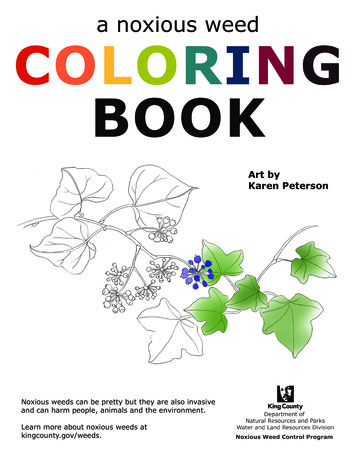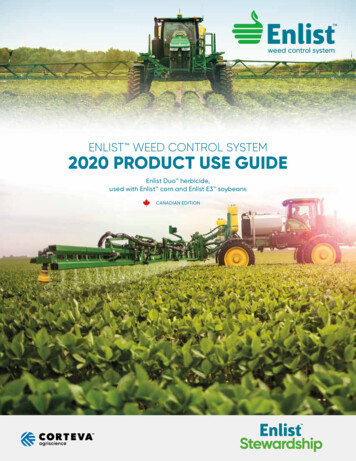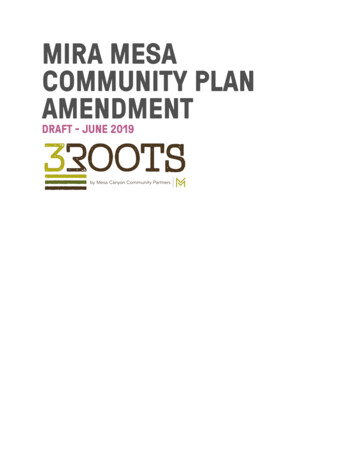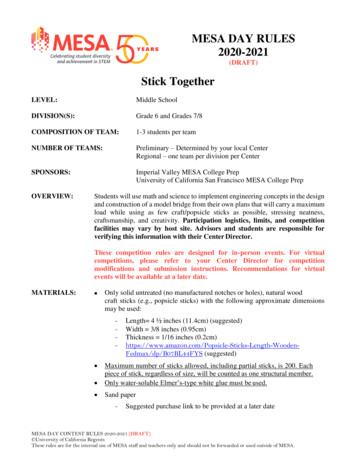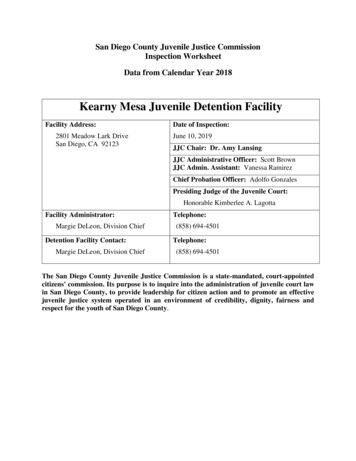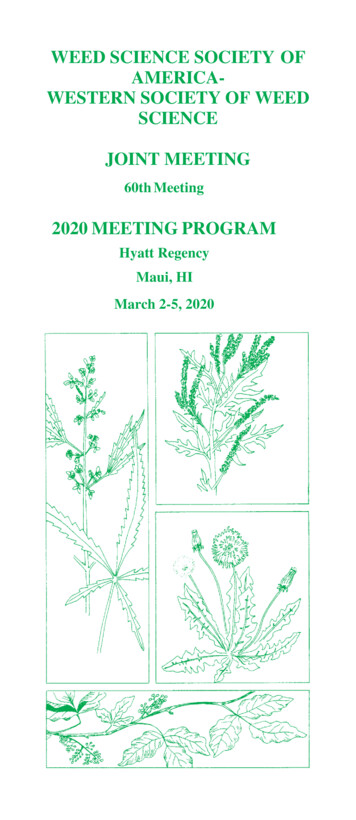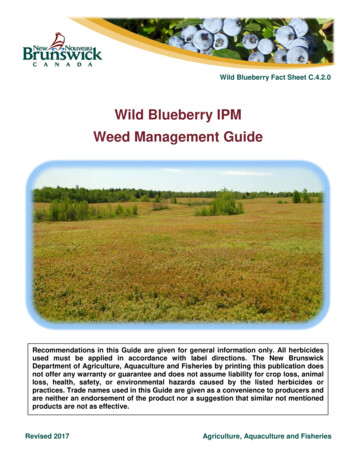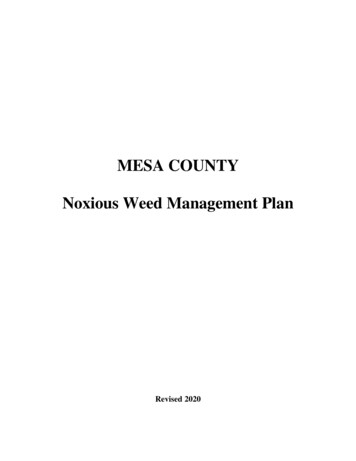
Transcription
MESA COUNTYNoxious Weed Management PlanRevised 2020
Table of ContentsDefinitions & Abbreviations . 41.0 Authority: Colorado Noxious Weed Act (Act): C.R.S. Title 35, Article 5.5 . 81.1 Purpose of C.R.S. Title 35, Article 5.5. 81.2 Duties to Manage Noxious Weeds . 81.2.1 County Noxious Weed Management Plan and Weed Advisory Board . 81.2.2 Coordinated Efforts between the State and County. 91.2.3 Designation of Colorado List A, B and C Noxious Weeds.91.2.4 Procedure for Enforcement of Eradication - List A and List B Species . 101.2.5 Procedure for Management of Species not Designated for Eradication . 111.2.6 Nuisance Declaration, Interagency Agreements and Funding . 111.3 Mesa County Noxious Weed List . 122.0 Goals & Objectives for Noxious Weed Management in Mesa County . 153.0 Operating Procedures for the Mesa CountyNoxious Weed Program . 163.1 Prioritizing County Weed Management Efforts. 163.1.1 High Priority. 163.1.2 Medium Priority . 163.1.3 Low Priority . 173.2 Coordination of Weed Management Activities . 173.2.1 Non-County Entities . 173.2.2 County Divisions . 183.3 Mapping . 183.3.1 Rights-of-Way . 183.3.2 County Owned Properties . 183.3.3 Private Property . 183.4 Licensing & Education . 193.4.1 Public Education .193.4.2 Licensing & Education for Program & Employees.193.5 Management of Noxious Weeds on Private Property . 193.5.1 Responsibility of Landowners . 193.5.2 Public Requests for Assistance . 203.5.3 Procedure for Enforcement.203.5.3.1 Scenarios Requiring Compliance or Enforcement.203.5.3.2 Program Responsibility .203.5.3.3 Complaints.213.5.3.3.1 Verification of Infestation & Notification of Inspection.213.5.3.3.2 Notification of Confirmed Infestation.213.5.3.3.3 Enforcement Notice.223.5.3.3.4 Enforcement Action.223.5.3.3.5 Billing.223.5.4 Mesa County Noxious Weed Cost-Share Program . 233.6 Noxious Weed Treatment by the County on Private Property . 233.7 Funding of Weed Management Project . . . 23Appendices . 25Appendix A. A Guide to Developing a Weed Management Plan . 262Revised April 2020
A1 Weed Identification . 26A2 Mapping Infestations . 26A3 Determining a Management Strategy . 26A4 Preparing a Weed Management Plan . 27A5 Principles for Integrated Weed Management . 27Appendix B. Best Management Practices for Noxious Weeds in Mesa County. 29B1 General Guidelines . 29B2 Control of Annuals & Biennials . 30B3 Control of Perennials . 31B4 Integrated Pest Management Practices . 31B4.1 Prevention . 31B4.2 Cultural Practices . 32B4.3 Mechanical Control . 32B4.4 Biological Control. 33B4.5 Chemical Control . 34Appendix C. Cost-Share Program.35C1 Introduction.35C2 Application Proces. .35C3 Eligibility. .35C4 Reimbursement .35C5 Reasons for Disqualification or Denial .36Appendix D. Resources.37Table 1: Mesa County Noxious Weed List and Management Priority Listing . .133Revised April 2020
Definitions & Abbreviations1. Act: the Colorado Noxious Weed Act, Title 35, Article 5.5, Colorado Revised Statutes(C.R.S.) as amended.2. Annual weed: a weed that lives for one year then dies. Seeds are the primary dispersalmechanism for annual plants.3. Arbitration panel: In an enforcement situation involving noxious weeds that are not slatedfor eradication, a landowner may request an arbitration panel to determine amanagement plan for the landowner’s infested property. The arbitration panel is chosenby the local governing body and “shall be comprised of a weed management specialistor weed scientist, a landowner of similar land in the same county, and a third panelmember chosen by agreement of the first two panel members.” (C.R.S. 35-5.5109(4)(b)).4. Authorized agent: a local or State government employee or appointed pest inspector.5. Best Management Practices: recommendations for the most reasonable, effective andeconomical but least harmful methods of weed control including appropriate integratedweed management methods.6. Biennial weed: a weed that has a two year life cycle. It germinates and grows leaves oneyear, then sends up a flower stalk and sets seed the following year. Seeds are the primarydispersal mechanism for biennial plants.7. Biological control: see “Integrated Weed Management”8. Biocontrol agent: a living creature that is used to control undesirable pests. Includesinsects, diseases, and vertebrate animals, among others.9. BOCC: Mesa County Board of Commissioners.10. Bolting: a stage in the life cycle of a plant when it sends up a flower stalk.11. CDA: Colorado Department of Agriculture12. Chemical control: see “Integrated Weed Management”13. Commissioner: Commissioner of the Colorado Department of Agriculture (a.k.a.Commissioner of Agriculture)14. Containment: see “Management criteria”15. State Coordinator: Colorado State Weed Coordinator under contract with, or appointedby the Commissioner of Agriculture.16. County: Mesa County4Revised April 2020
17. Cultural control: See “Integrated Weed Management”18. Elimination: removing and destroying live plants of List A or List B species designatedfor eradication, and preventing seed production until the seed source is depleted considered the first step in the eradication process.19. Eradication: see “Management criteria”.20. Infestation: An area of land overrun with or dominated by weed species.21. Integrated Weed Management: the planning and implementation of a coordinatedprogram that uses a variety of effective tools to manage noxious weeds. Elements of anIWM plan include weed identification, education, prevention, cultural practices,mechanical removal, chemical use, and biological control.a. Biological control: the deliberate introduction of living agents (natural enemies),such as insects, vertebrate predators, grazing animals, and plant diseases, toreduce the population of a pest.b. Chemical control: the use of one or more herbicides to damage or destroytargeted plants by spraying, injection, painting or other proper and legal method.c. Cultural control: sensible land management practices such as dense seeding withcompetitive species, crop rotation, careful irrigation practices, properfertilization, and sensible grazing regimes.d. Mechanical control: the physical removal of a weed by such methods as pulling,hand grubbing, rogueing, hoeing, burning, grazing, tillage, plowing, solarizationand mowing.22. Landowner: any owner of record of State, federal, county, municipal, or private land.23. List A Species: “ rare noxious weed species that are subject to eradication whereverdetected Statewide in order to protect neighboring lands and the State as a whole.”(C.R.S. 35-5.5-108(2)(a)(I)).24. List B Species: “ noxious weed species with discrete Statewide distributions that aresubject to eradication, containment, or suppression in portions of the State designated bythe commissioner in order to stop the continued spread of these species.” (C.R.S. 3-5.5108(2)(a)(II)).25. List C Species: “ widespread and well-established noxious weed species for whichcontrol is recommended but not required by the State, although local governing bodiesmay require management.” (CSR 3-5.5-108(2)(a)(III)).26. Management criteria: the specific desired result of integrated weed management effortsincluding:a. Containment: “ maintaining an intensively managed buffer zone that separatesinfested regions, where suppression activities prevail, from largely uninfestedregions, where eradication activities prevail.” (C.R.S. 35-5.5-103(11.7)(b)).5Revised April 2020
b. Eradication: “ reducing the reproductive success of a noxious weed species orspecified noxious weed population in largely uninfested regions to zero andpermanently eliminating the species or population within a specified period oftime. Once all specified weed populations are eliminated or prevented fromreproducing, intensive efforts continue until the existing seed bank is exhausted.”(C.R.S. 35-5.5-103(11.7)(a)).c. Suppression: “ reducing the vigor of noxious weed populations within aninfested region, decreasing the propensity of noxious weed species to spread tosurrounding lands, and mitigating the negative effects of noxious weedpopulations on infested lands.” Suppression efforts may employ a wide variety ofintegrated management techniques. (C.R.S. 35-5.5-103(11.7)(c))27. Mechanical control: see “Integrated Weed Management”28. Neighboring: a property with a boundary immediately adjacent to the boundary ofanother property.29. Noxious weed: a non-native plant that has been designated by State rule as beingnoxious or has been declared a noxious weed by a County Advisory Board, and meetsone or more of the following criteria:A. aggressive invaders detrimental to agriculture or native plant communities,B. may be poisonous to livestock,C. may be carriers of or hosts to insects, diseases or parasites,D. are detrimental to sound management of native or agricultural ecosystems.30. Noxious weed list: a list of weed species subject to specific management regulations orotherwise of concern to a governing agency. The Colorado Noxious Weed List (“StateList”) categorizes noxious weeds as A, B, C and Watch List species and is created by theState Noxious Weed Advisory Committee and approved by the Commissioner.The Mesa County Noxious Weed List (“County List”) is composed of State List speciespresent in the County and may include additional species of concern. The County List iscreated by the Mesa County Weed Advisory Board and approved by the BOCC.31. Perennial weed: a weed that lives for 3 or more years. These species usually spread byroot systems or root pieces, as well as seeds.32. Propagules: plant parts (e.g. seeds and root pieces) that have the ability to give rise tonew plants.33. Program: Mesa County Noxious Weed & Pest Management, and County employeesworking for and with the Program.34. Program Coordinator: the agent or Mesa County employee designated by the BOCC tosupervise and direct weed management in accordance with the Mesa County NoxiousWeed Management Plan.35. Rosette: a circular growth of leaves that forms after germination of some plants.6Revised April 2020
36. ROW: right-of-way, or, rights-of-way37. Rules: Rules Pertaining to the Administration and Enforcement of the Colorado NoxiousWeed Act (8 CCR 1206-2)38. State: State of Colorado39. State Noxious Weed: any noxious weed identified by rule by the Commissioner of theColorado Department of Agriculture.40. Suppression: see “Management criteria”41. Weed Advisory Board (“WAB”): the Mesa County Weed Advisory Board are thecitizens appointed by the Board of County Commissioners to advise on management ofnoxious weeds in the County jurisdiction.42. Weed management plan: a noxious weed management plan developed by any person,agency, the Commissioner or the Board, using integrated weed management techniques,methods or practices. The Mesa County Noxious Weed Management Plan is thisdocument and is referred to as the “Plan”.7Revised April 2020
1.0 Authority: Colorado Noxious Weed Act (Act): C.R.S. Title 35, Article 5.5,as Amended1.1 Purpose of C.R.S. Title 35, Article 5.5Certain undesirable plants, primarily aggressive non-native invaders, constitute a threat tothe “continued economic and environmental value of the lands of the State and if present in anyarea of the State must be managed” These species must be managed in an organized andcoordinated manner on private and public lands, using integrated management techniques “whichare least damaging and which are practical and economically reasonable.” (C.R.S. 35-5.5-102)1.2 Duties to Manage Noxious WeedsAs mandated by the Colorado Noxious Weed Act (C.R.S. 35-5.5-104), all persons shallcontrol noxious weeds on their property if such plants are a threat to neighboring landowners ornatural ecosystems. Weed control programs should be integrated in their approach, using allavailable technologies to achieve effective weed control.It is unlawful for persons to “intentionally introduce, cultivate, sell, offer for sale, orknowingly allow to grow” any species recognized as a noxious weed by the State (C.R.S. 35-5.5104.5(1)(a)), with a few exceptions (C.R.S. 35-5.5-104.5(1)(a)(I-V)).1.2.1 Mesa County Noxious Weed Management Plan & Weed Advisory BoardTo comply with the Act, the Mesa County Board of Commissioners (BOCC) has adoptedthis Mesa County Noxious Weed Management Plan (Plan) for all of the unincorporated landswithin its jurisdiction. The BOCC may adopt regulations, ordinances or resolutions to enforcethis Plan and promote noxious weed management in the county. The Mesa County NoxiousWeed & Pest Management Coordinator (Program Coordinator) and other authorized agents ofMesa County (County) may be used to enforce noxious weed control and to otherwise administerthe provisions of the Act. (C.R.S. 35-5.5-105)Local landowners are appointed by the BOCC to the Mesa County Weed Advisory Board(WAB) to advise on noxious weed management in County jurisdiction. The WAB has the powerand duty to: develop the Mesa County Noxious Weed Management Plan, recommendmanagement criteria and integrated management methods for noxious weeds, propose species forinclusion in the Mesa County Noxious Weed List, review and revise the Plan as needed at leastonce every three years and submit it to the BOCC. The WAB can request that specificlandowners submit weed management plans (Appendix A) when appropriate. (C.R.S. 35-5.5107)The BOCC may choose to approve, modify or reject weed management plans, or anyother recommendations of the WAB; however, management plans for species with Statedesignated eradication plans cannot be rejected unless the County submits a waiver ofcompliance to the Commissioner of the Colorado Department of Agriculture (Commissioner)(Rules: 8 CCR 1206-2 Part 6).1.2.2 Coordinated Efforts between the State and CountyThe Colorado Department of Agriculture (CDA) has determined that “an organized andcoordinated effort must be made to stop the spread of noxious weeds” (C.R.S. 35-5.5-102). This8Revised April 2020
effort is facilitated by the Colorado Noxious Weed Coordinator (State Coordinator) who buildslocal coalitions and coordinates efforts of state, federal, local, and private landowners indeveloping a state weed management plan for each species on the Colorado Noxious Weed List.When requested by the State Coordinator, the authorized agent from each county willsubmit a management plan for a particular species proposing which level of control will beimplemented in their respective county: eradication, suppression, or containment. The StateCoordinator compiles all recommendations and submits a State weed management plan for eachspecies, as requested, to the Colorado State Noxious Weed Advisory Committee (Committee).The Committee reviews and recommends the noxious weed management plans to theCommissioner who, via the State legislature, incorporates the plans into the Rules (Rules: 8 CCR1206-2).1.2.3 Designation of Colorado List A, B & C Noxious WeedsThe Rules designate and classify noxious weeds into three categories (C.R.S. 35-5.5-108), andthe Commissioner prescribes acceptable management criteria for each species on Lists A and B. “List A” species are designated as weeds to be eradicated throughout Colorado.Eradication of all List A species is required whether or not they appear on an individualcounty’s noxious weed list. List A species management plans prioritize control methodsthat are intended to kill/remove all plants of that species, and prevent future re-growththrough seed spread/root propagules. “List B” species are further established species for which the intent of weed managementplans is to stop their continued spread. List B species management plans are created on acounty-by-county basis. Plans may require eradication, containment, or suppression of acertain species in designated areas depending upon the population and coverage of thenoxious weed. List B species designated by the State Coordinator for eradication inMesa County are described as “List A” species on the Mesa County Noxious Weed List. “List C” species are typically widespread within Colorado. The weed management plansfor List C species, when adopted, will be designed “to support the efforts of localgoverning bodies to facilitate more effective integrated weed management.” “The goal ofsuch plans will be to provide additional education, research, and biological controlresources to jurisdictions that choose to require management of List C species.” (Rules:Section 5.2) “Watch List” species are those that pose a potential economic or ecologic threat but areyet to have any State regulation. The purpose of the Watch List is to encourageidentification and reporting of these species to the State to assist in determining whichspecies should be designated as noxious weeds.Visit the CDA website (Appendix D) or contact the Program for a complete ColoradoNoxious Weed List.Local governments or landowners may request a compliance waiver from theCommissioner that releases the local government or landowner from “certain obligations oferadication for a specific population of a List A or List B species” (C.R.S. 35-5.5-108.5 (2.7)).9Revised April 2020
The Mesa County Noxious Weed List (“List) and management criteria for List A and Bspecies can be found in Section 1.3 and Table 1 of this document.1.2.4 Procedure for Enforcement of Eradication - List A and List B SpeciesLocal governing bodies shall “initiate and maintain contact with landowners who areaffected by list A species and populations of list B species designated for eradication” (C.R.S.35-5.5-108.5(3)). Each county shall “provide affected landowners with technical assistance”(C.R.S. 35-5.5-108.5(3)(b)(I)) and “carry out sufficient measures, including project oversight andenforcement” (C.R.S. 35-5.5-108.5(3)(b)(II)) to ensure that eradication of so designated speciesis accomplished. (C.R.S. 35-5.5-108.5(3)(b)(III, IV)) Each county shall “provide theCommissioner with assistance in disseminating financial resources to affected landowners andmapping data pursuant to the rules promulgated by the Commissioner, and determine the cost oferadication to be borne by the landowners.” The Commissioner may implement eradicationprograms directly if a county fails to perform its duties in regards to eradication.A landowner affected by any list A species or a List B species designated for eradicationshall allow the authorized agent(s) of the county access to the affected property for the purposeof inspection and eradication when at least one of the following conditions occur:“(a) The affected landowner or occupant has requested the inspection; or(b) A neighboring landowner or occupant has reported a suspected noxious weedinfestation and requested an inspection; or(c) An authorized agent of the local government or Commissioner has made a visualobservation from a public right-of-way or area and has reason to believe that a noxiousweed infestation exists.” (C.R.S. 35-5.5-108.5 (4))If a noxious weed infestation is suspected, a letter must be sent via certified mail definingthe problem and requesting an inspection. If entry is refused or there is no response from thelandowner after 10 days from the mailing date of the certified letter, an inspection warrant mustbe obtained by the authorized agent from a county or district court before an inspection isconducted (CSR 35-5.5-108.5(5)(b)(I)). A landowner cannot deny entry to inspect if a warrant issecured.After inspection, a notice outlining the problem, stating steps to be taken for eradicationand advising the landowner to commence eradication within a specified time frame shall be sentby certified mail. Within five (5) days of mailing the certified letter, the landowner shall complywith the recommendations or submit an acceptable noxious weed eradication plan. The countyshall take action in the case of failure of the landowner to comply with the Act, by implementingthe eradication plan, and assessing the entire cost of the eradication action to the landowner. Theassessment becomes a lien on the property until paid. Funds collected shall be used in thefurtherance of the county’s weed management efforts.Once an eradication effort is made, the county has the right to enter the property to ensurecompliance with the requirements of the eradication plan. The landowner may apply to theCommissioner for a waiver of compliance for species with an eradication designation (C.R.S.108.5(14).The county cannot compel a private owner to control weeds without first applying thesame control measures on any county-owned land or rights-of-way adjacent to the privateproperty in question. If the county fails to take the actions outlined above for List A and List Bspecies designated for eradication, the Commissioner is authorized to perform the eradicationeffort.10Revised April 2020
State agencies have the same responsibility as private landowners for List A and List Bspecies designated for eradication (C.R.S. 35-5.5-110). Notification by the county is the same asfor private landowners. The county has the power to enter infested public lands and undertakethe eradication effort if the State agency does not comply with the eradication plan. The Stateagency having jurisdiction over the treated land shall pay for the expenses associated with theeradication effort. The county may enter into a written reimbursement agreement with the Stateagency.1.2.5 Procedure for Enforcement of Management of Species Not Designated forEradicationA landowner affected by either List B or List C species designated for containment orsuppression shall allow the authorized agent(s) of the county access to inspect the affectedproperty when at least one of the following conditions occur:“(a) The affected landowner or occupant has requested the inspection; or(b) A neighboring landowner or occupant has reported a suspected noxious weedinfestation and requested an inspection; or(c) An authorized agent of the local government or Commissioner has made a visualobservation from a public right of way or area and has reason to believe that a noxiousweed infestation exists.” (C.R.S. 35-5.5-109)Before entering private property, the landowner or occupant must be notified of thepending inspection by certified mail. If entry is refused, an inspection warrant must be obtainedby the authorized agent before the property can be inspected (C.R.S. 35-5.5-109(2)(b)). Alandowner cannot deny entry to inspect if a warrant is secured. When noxious weeds areidentified on a property, the authorized agent shall notify the landowner by certified mail whichnoxious weeds were found, how to control those weeds, and advise them to begin managementwithin a specified time frame. Within 10 days of receipt of notification, the landowner oroccupant must comply with the recommendations, submit an acceptable weed management plan,or request an arbitration panel hearing (C.R.S. 35-5.5-109(4)(a)). The county has the authority tocontrol the weeds in the case of failure by the landowner to comply with the notification andassess the cost of control plus overhead expenses, up to 20% (C.R.S. 35-5.5-109(5)(a)(II)). Thecounty has the right to enter the property to ensure compliance with the requirements of themanagement plan. The county cannot force a private owner to control weeds without first havingequal or greater control measures on any county-owned lands adjacent to the private property inquestion.1.2.6 Nuisance Declaration, Interagency Agreements and FundingNoxious weeds may be declared a public nuisance, subject to all applicable laws andremedies for abatement (C.R.S. 16-13, Part 3), including removal or destruction of the weeds(C.R.S. 35-5.5-113).The county may enter into cooperative agreements for weed management with State andfederal agencies (C.R.S. 35-5.5-111). Public lands under the jurisdiction of the county, includingroads, highways, rights-of-way, and easements, must be in compliance with the Act (C.R.S. 355.5-112).A State noxious weed management fund was established to fund grants or contracts forweed management projects and education including procedures for allocation of funds toappropriate entities (C.R.S. 35-5.5-116). Each county may levy a tax of not more than 5 mils,upon voter approval, to fund noxious weed management programs (C.R.S. 35-5.5-119).11Revised April 2020
1.3 Mesa County Noxious Weed ListEach county adopts a noxious weed list for weeds of importance to their county. TheMesa County Noxious Weed List includes 29 weeds as of 2017 (Table 1). Mesa County “A”species are Colorado List A species known to exist/have existed in the County, and List Bspecies designated for eradication in the County. Mesa County “B” species include ColoradoList B and List C species, each with specified management criteria for Mesa County.Weeds that are not on a Colorado Noxious Weed List or that do not have a State weedmanagement plan may be designated as a Mesa County noxious weed by the BOCC. Anyperso
may require management." (CSR 3-5.5-108(2)(a)(III)). 26. Management criteria: the specific desired result of integrated weed management efforts including: a. Containment: " maintaining an intensively managed buffer zone that separates infested regions, where suppression activities prevail, from largely uninfested
